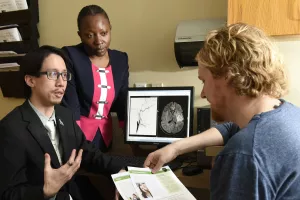Tufts Medicine cares for people with a wide range of neurological conditions like migraines, brain infections, spinal cord injuries and neuromuscular disorders like amyotrophic lateral sclerosis (ALS), to name a few.
Heading in the right direction
We specialize in diagnosing and treating complex neurological conditions affecting millions globally. The World Health Organization estimates that 24 million people have Alzheimer's disease and 326 million people have migraines.
There are more than 600 neurological disorders that can be the result of:
- Brain tumors
- Defective genes
- Degenerative diseases (diseases that worsen over time)
- Environmental exposures
- Infections
- Physical injury
- Problems with blood vessels
- Lifestyle
- Nervous system impairment
Neurological conditions caused by other chronic conditions can impact your short and long-term health and your ability to do many things you enjoy. We partner with you and your primary care physician to develop a personalized care plan that maximizes your quality of life and keeps you moving forward.

Conditions
You can count on us to provide compassionate and supportive care for neurological conditions, including:
Testing
We use advanced, cutting-edge technology to diagnose and monitor neurologic disorders accurately. Symptoms can be physical (lack of muscle control, poor coordination, pain) and emotional (mood swings, outbursts, etc.).
We are experts at detecting changes in your nervous system and use a number of tests to assess your balance, reflexes, coordination and how well your brain functions.
In addition to a physical exam, we may also recommend tests, including:
- Blood tests
- Biopsies
- Carotid doppler ultrasound
- Cerebrospinal fluid analysis
- Computerized tomography angiography scan
- Computerized tomography (CT) scan
- Electroencephalograms (EEG)
- Electromyogram (EMG)
- Electroneurogram (ENG)
- Eye movement analysis
- Genetic testing
- Lumbar puncture (spinal tap)
- Magnetic resonance angiography (MRA)
- Magnetic resonance imaging (MRI)
- Muscle biopsy
- Nerve conduction studies
- Positron emission tomography scan (PET)
Treatments
While there is no cure for many neurologic disorders, promising new therapies can repair and restore functions to improve your well-being and help you live a more independent life.
Not everyone with a neurologic disorder will need surgery, and treatment depends on your condition's severity. There are many effective treatment options to help manage symptoms, including:
- Clinical trials
- Deep brain stimulation
- Medications
- Occupational therapy
- Physical therapy
- Rehabilitation

From regular office visits to inpatient stays, find the healthcare you need and deserve close to home.

Meet the doctors and care team devoted to supporting you every step of the way along your path to better health.